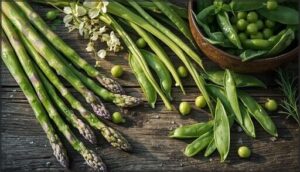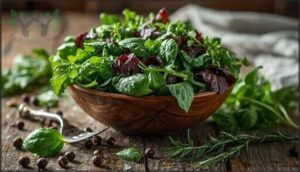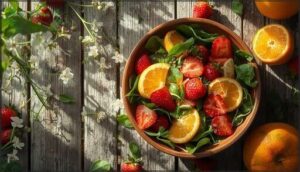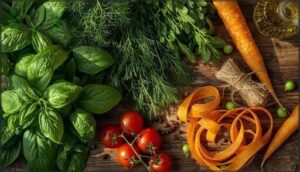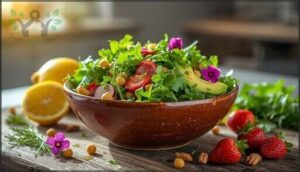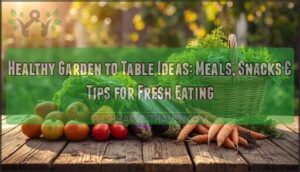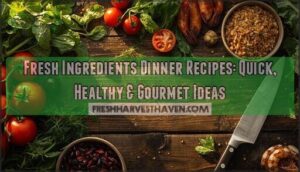This site is supported by our readers. We may earn a commission, at no cost to you, if you purchase through links.
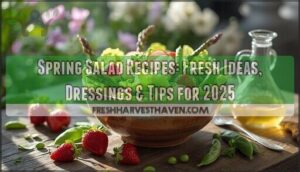
You don’t need complicated techniques or exotic ingredients to build salads that satisfy both your appetite and your body’s needs. Smart combinations of seasonal produce, protein-rich additions, and well-balanced dressings transform simple greens into meals that carry you through warm afternoons without leaving you hungry an hour later.
Table Of Contents
- Key Takeaways
- Essential Ingredients for Spring Salads
- Flavorful Spring Salad Dressings
- Classic Spring Salad Recipes
- Creative Spring Salad Variations
- Tips for Preparing and Serving Spring Salads
- Frequently Asked Questions (FAQs)
- What is in the Jennifer Aniston salad?
- What is a good salad dressing for spring mix?
- What is bright spring salad?
- What do I need to make a spring salad?
- How to make the dressing for a spring salad?
- What’s a good spring salad?
- How do you make chicken salad for spring?
- What do you put in spring salad?
- What is the Jennifer Aniston salad?
- What is typically in spring mix salad?
- Conclusion
Key Takeaways
- Spring vegetables like asparagus and peas deliver exceptional nutritional density (57% daily vitamin K and 8g plant protein per serving) during their March-June peak season, making timing your salads around fresh harvest critical for both flavor and health benefits.
- The foundation of satisfying spring salads relies on combining three elements—seasonal produce at peak freshness, substantial protein sources (ranging from 6-31g per serving depending on choice), and balanced dressings using the classic 3:1 oil-to-acid ratio.
- Simple preparation techniques like cold water washing, proper drying with a salad spinner, and brief blanching (90-180 seconds) for vegetables preserve crispness and boost flavor by up to 35% when served at room temperature rather than cold.
- Make-ahead strategies work best with sturdy greens and grain-based salads that improve over time, while keeping dressings separate until serving prevents sogginess and extends freshness up to five days for meal prep.
Essential Ingredients for Spring Salads
Spring salads taste best when you build them around what’s actually in season right now. The ingredients you choose set the tone for everything—whether you’re going for bright and tangy, rich and satisfying, or somewhere in between.
Let’s look at the essentials that’ll make your spring salads worth making again and again.
Fresh Spring Vegetables (asparagus, Peas, Green Beans)
Asparagus, peas, and green beans are the backbone of any great spring salad. Asparagus delivers 57% of your daily vitamin K in just half a cup, while peas pack 8 grams of plant-based protein per serving. Green beans bring vitamin C and a satisfying crunch.
Harvest season runs March through June—that’s when you’ll find garden-fresh produce at its peak flavor and nutrition. To boost the benefits of these vegetables, consider exploring seasonal eating tips for the best results.
Peppery Greens (arugula, Spinach, Spring Mix)
Now let’s talk about greens that bring real personality to your bowl. Arugula delivers a peppery punch with 355.5 micrograms of lutein and zeaxanthin per cup—antioxidants that support eye health. Spinach offers 144.87 micrograms of vitamin K and nearly 3,000 IU of vitamin A.
Spring mix combines up to 16 baby greens, blending sweet and bitter flavors for layered depth you can’t get from iceberg alone. The nutritional benefits of spring mix greens make them a great addition to a healthy diet.
Seasonal Fruits and Berries (strawberries, Citrus)
Fresh berries and citrus bring color, tang, and real nutritional punch to your spring salads. Strawberries peak in April and May, offering 59 mg of vitamin C per 100 grams—that’s 65% of your daily needs.
Citrus varieties like oranges and lemons pair beautifully with spinach or arugula, and their bright acidity helps your body absorb more nutrients from those greens. Berry nutrition meets flavor in every bite.
Fresh Herbs (mint, Basil, Dill)
Beyond berries and citrus, your spring salad needs aromatic oils from fresh herbs. Basil, mint, and dill don’t just season—they transform.
These three deliver massive flavor without extra salt or fat, and they’re nutrition powerhouses: dill packs 85 mg vitamin C per 100 grams, while basil triples dill’s copper content.
Try herb pairings: basil with tomatoes, dill with carrots, mint with peas. Fresh picking beats dried every time.
Plant- and Animal-Based Proteins (chicken, Eggs, Quinoa, Seafood)
Protein turns greens into a meal. You’ve got options: chicken delivers 31 grams per 3.5-ounce serving, shrimp hits 24 grams, eggs provide 6 grams per large egg, and quinoa (a complete protein) offers 8 grams per cooked cup.
Five go-to protein sources:
- Grilled chicken for avocado chicken salad or Cajun Cobb Salad with Shrimp
- Hard-boiled eggs in classic chicken salad
- Salmon for omega-3 boost
- Quinoa for plant-based meal prep ideas
- Shrimp in shrimp pasta salad or Shrimp Cobb Salad
These protein sources deliver nutrient profiles and dietary benefits that satisfy hunger.
Flavorful Spring Salad Dressings
A great spring salad needs more than fresh vegetables—it deserves a dressing that brings everything to life. The right blend of tangy, creamy, or herbaceous flavors can transform simple greens into something you’ll actually crave.
Here are four dressing styles that capture the bright, vibrant spirit of the season.
Lemon-Mustard Vinaigrette
A bright, tangy lemon-mustard vinaigrette can transform your spring salad from simple to unforgettable. The beauty of homemade recipes lies in their ability to let you control sodium levels and skip additives, making them a healthier choice. This vinaigrette pairs perfectly with arugula, quinoa bowls, and even grilled chicken marinades.
You’re looking at about 126 calories per 28g serving, packed with heart-healthy olive oil and zero cholesterol.
| Component | Amount per Serving |
|---|---|
| Calories | 126 (28g serving) |
| Total Fat | 14g |
| Sodium | 69-188mg |
Creamy Herb Dressings (dill, Basil, Mint)
Silky herb emulsions bring garden-fresh flavors to your spring salad without the heaviness of store-bought options. Greek yogurt or sour cream forms the creamy base, while dill, basil, and mint deliver those bright herbal variations you’re craving.
Here’s what makes these creamy salad dressings work:
- Fat content – Just 3-4 tablespoons oil per cup keeps texture smooth
- Fresh herbs – ¼ cup each creates balanced flavor profiles
- Dressing stability – Lemon juice preserves brightness for five refrigerated days
Balsamic and Citrus-Based Dressings
Vinaigrette trends are shifting toward lighter, tangier flavor profiles—and you’re seeing balsamic varieties paired with honeydew or citrus flavors like lemon ricotta to lift spring greens.
Fresh herbs in these salad dressings heighten seasonal brightness. A 2-tablespoon pour delivers 100–143 calories, with dressing nutrition leaning on monounsaturated fats and minimal sodium when you choose quality oils.
Tips for Balancing Flavors in Dressings
You’ll nail flavorful salad dressings once you master acid balance and fat ratios—that classic 3:1 oil-to-vinegar formula creates a stable emulsion and balanced salad flavors. Whisk slowly to boost stability by 85%, keeping your homemade dressing smooth.
Master the classic 3:1 oil-to-vinegar ratio and whisk slowly to create flavorful, stable homemade dressings every time
Add sweetness or umami (think mustard or garlic) to round out sharp vinaigrette, then toss in fresh herbs last to preserve their brightness and dressing textures.
Classic Spring Salad Recipes
Sometimes the best recipes are the ones that let spring’s natural flavors shine without a lot of fuss. These classic salads combine crisp vegetables, fresh herbs, and bright dressings that taste like the season itself.
Whether you’re craving something sweet and tangy or light and herbaceous, you’ll find a go-to option here.
Strawberry Spinach Salad
Looking for a spring salad that’s equal parts gorgeous and satisfying? Strawberry Spinach Salad is your answer. This crowd-favorite balances peppery baby spinach with sweet, juicy strawberries, making it perfect for meal planning during peak seasonal availability from March through June.
Here’s what makes it work:
- Nutrition facts that shine: around 160–350 calories per serving
- Fresh herbs and nuts for crunch and healthy fats
- Calorie count that flexes based on your protein choices
- Simple food safety—just rinse, toss, and serve
Spring Cobb Salad With Lemon-Dill Dressing
Want a spring salad that packs 44g of protein and actually fills you up? Spring Cobb Salad with lemon-dill dressing delivers crunchy asparagus, sugar snap peas, bacon, and hard-boiled eggs over spring greens.
The bright vinaigrette—fresh dill, lemon juice benefits, and Dijon—ties it all together.
Salad meal prep fans love this: assemble rows of ingredients ahead, dress right before serving, and you’re golden.
Greek Salad With Fresh Herbs
Craving something bright and boldly Mediterranean? Greek Salad with fresh herbs brings you tomatoes, cucumber, bell pepper, kalamata olives, and feta—all tossed with dill, mint, oregano, and a simple olive oil–red wine vinegar dressing.
You’ll get 166% of your daily vitamin K and heart-healthy fats per serving. It’s Greek cuisine at its easiest, ready in 15 minutes.
Bruschetta Pasta Salad With Tomatoes and Basil
If you’re chasing Italian-inspired pasta salad recipes with a fresh twist, bruschetta pasta salad brings multi-colored tomato varieties, fragrant basil benefits, and tangy balsamic together for summer entertaining.
At 160 calories per serving, you’ll get lycopene for heart health and calcium from mozzarella.
Inspired by pasta salad history and Italian inspirations, this spring salad recipe pairs perfectly with roasted chicken or grilled salmon.
Lemon, Ricotta & Asparagus Pasta Salad
Another spring salad recipe that celebrates seasonal vegetables is lemon ricotta asparagus pasta salad—a lighter, invigorating option you’ll want at every gathering. Blanched asparagus prep ensures crisp texture, while whole-milk ricotta type delivers creamy tang without heaviness. Vegan adaptations swap cashew ricotta and nutritional yeast seamlessly.
Try these herb pairings for extra brightness:
- Fresh basil adds sweet anise notes
- Mint brings cool contrast
- Parsley offers clean, grassy flavor
- Dill complements lemon beautifully
- Chives add mild onion bite
Serving temperature? Cold or room-temp works perfectly.
Creative Spring Salad Variations
Spring salads don’t have to follow the same old formula. You can shake things up with unexpected proteins, bold textures, and ingredients that work around dietary needs without sacrificing flavor.
Here’s how to turn a basic bowl of greens into something that actually excites your taste buds.
Chicken and Bread Panzanella Salad
Imagine a spring chicken panzanella salad with crispy, golden bread cubes soaking up tangy vinaigrette alongside juicy grilled chicken. This fresh take on the Italian classic combines bread texture tips and seasonal ingredient swaps to transform your spring recipes.
| Component | Quick Prep Guide |
|---|---|
| Chicken | Grill 2–3 minutes per side over medium heat |
| Bread | Toast at 325–425°F for 10–30 minutes until golden |
| Spring Veggies | Blanch snap peas and asparagus 2–4 minutes, cool in ice water |
Use day-old artisan bread cut into ½-inch cubes—about 3 to 4 cups—and boneless chicken breasts for protein. Add vine-ripened tomatoes, fennel, cucumbers, and at least 12 fresh basil leaves. For the dressing, whisk together olive oil with sherry or red wine vinegar, adding 2 to 4 tablespoons per batch for a bright, tangy kick.
Assemble this spring salad right before serving to keep the bread crisp and flavors vibrant. If storing leftovers, seal them in an airtight container for up to 24 hours, though the bread may lose some crunch. Each serving contains 461 calories and 46 grams of protein, making it perfect fuel for outdoor gatherings this season.
Vegan and Plant-Based Options (quinoa, Navy Beans, Veggies)
With quinoa, navy beans, and fresh vegetables, you’ll build a vegan spring salad that delivers complete protein and over 35% of your daily fiber in one satisfying bowl. These plant-based dressings and seasonal vegan recipes transform simple ingredients into meals that fuel your body and celebrate the season.
- Vegan protein sources: Navy beans pack nearly 20 grams of protein per cooked cup, while quinoa adds 8 grams plus essential amino acids.
- Vegan nutrition benefits: One serving meets your daily vitamin C needs and provides sustained energy through balanced macronutrients.
- Vegan salad prep: Combine asparagus, peas, arugula, and edamame with fresh herbs like mint and basil for maximum flavor.
- Seasonal vegan recipes: Source local greens and vegetables at farmer’s markets for 20% higher vitamin retention and peak freshness.
Seafood Salads (salmon, Shrimp)
Pairing salmon and shrimp with grapefruit and arugula gives your spring salads a burst of omega-3s and selenium while keeping prep under 30 minutes. Choose wild-caught or certified sustainable sourcing to reduce environmental impact, and experiment with recipe customization—swap in trout or scallops, then toss with citrus-based dressings.
These healthy recipes combine fresh ingredients and smart flavor pairings that make seafood safety and salad popularity work in your favor.
Salads With Bacon or Ham
You’ll love how bacon and ham transform spring salads into main-dish showstoppers. These protein-rich salads deliver 12–26 grams of protein per serving, perfect for using up holiday ham leftovers alongside spring peas, arugula, and cherry tomatoes.
Bacon salad calories range from 160–480 depending on your ham salad variations, so watch sodium content concerns—many recipes exceed 60% of your daily limit.
Gluten-Free and Allergy-Friendly Salads
You can enjoy spring’s best flavors without worry—over 99% of prepackaged salads contain no detectable allergens. Safe ingredients like quinoa, chickpeas, spring greens, and fresh herbs create delicious allergy-friendly dressings and healthy recipes.
Recipe adaptations swap gluten-free pastas or teff for traditional grains, while labeling compliance helps you avoid cross-contamination risks. Fresh ingredients mean better nutrition and peace of mind.
Tips for Preparing and Serving Spring Salads
You’ve got the recipes and the ingredients—now let’s talk about making these salads work for real life. The right prep techniques keep your greens crisp and your flavors bright, whether you’re packing lunch for the week or setting up a backyard spread.
Here’s how to handle everything from timing your prep to making your salads look as good as they taste.
Simple Preparation Methods for Crisp Results
Want salads that stay crisp? Cold water washing lifts dirt and restores snap—three to four changes do the trick. Sharp cutting methods beat tearing for uniform texture, and drying strategies with a salad spinner keep things fresh for days.
Try blanching techniques for asparagus (90–180 seconds, then ice water) to lock in that crunch.
Serve at room temperature—it boosts flavor by up to 35% compared to straight-from-the-fridge.
Make-Ahead and Meal Prep Ideas
Meal prep transforms spring salads into weekday wins. Layer sturdy greens like kale or romaine with quinoa, cherry tomatoes, and grilled chicken in portions—they’ll stay fresh for up to five days. Keep dressing separate until you’re ready to eat.
Weekly prep means four to five make-ahead side dishes ready to go. Mason jar salad layering works beautifully: dense ingredients first, delicate greens on top for ingredient longevity and easy salad preparation.
Colorful Presentations and Garnishes
Your eyes eat first—and salad ingredients shine brightest when you let color contrast do the talking. Visual attractiveness jumps when you:
- Layer reds, greens, and purples on white or dark plates for plate color impact
- Scatter edible flower use like chamomile or rose across the top
- Apply arrangement techniques that separate ingredients instead of tossing everything together
Fresh herbs and creative salad dressing drizzles seal the deal.
Best Salads for Picnics and Entertaining
Picnic food safety starts with cold storage—keep your spring salad below 40°F until you’re ready to eat.
Make-ahead tips favor pasta, bean, and grain salads; they hold up for hours outdoors and taste even better the next day. Ingredient trends spotlight hearty greens and pickled veggies for durability suitability.
Serving outdoors? Choose colorful, layered salad recipes with fresh ingredients that won’t wilt under pressure.
Frequently Asked Questions (FAQs)
What is in the Jennifer Aniston salad?
The viral salad includes bulgur, chickpeas, cucumber, tomato, feta, pistachios, and fresh herbs like parsley and mint.
Despite social media influence, Aniston clarified she ate a different Mediterranean salad on set.
What is a good salad dressing for spring mix?
Think of spring mix as a blank canvas waiting for the right brushstroke—a simple lemon-mustard vinaigrette, creamy herb dressing, or citrus-based option brings those tender greens to life perfectly.
What is bright spring salad?
A bright spring salad showcases vibrant, contrasting colors from seasonal produce like strawberries, radishes, and leafy greens.
This colorful presentation, paired with fresh flavors and crisp textures, creates invigorating salad recipes that celebrate spring cooking.
What do I need to make a spring salad?
You’ll need fresh produce like asparagus, peas, and leafy greens, plus seasonal ingredients such as strawberries.
Add protein—chicken, eggs, or quinoa—then finish with a tangy salad dressing for healthy recipes worth repeating.
How to make the dressing for a spring salad?
A good vinaigrette starts with a 3:1 oil-to-acid balance—olive oil paired with citrus or vinegar creates emulsion.
Fresh herbs like basil or dill boost flavor, while mustard adds depth and helps everything blend smoothly.
What’s a good spring salad?
A standout spring salad combines fresh greens like arugula or spinach with seasonal ingredients—asparagus, strawberries, radishes—plus protein like grilled chicken or quinoa.
Top with lemon-mustard vinaigrette for bright spring flavors that celebrate healthy toppings and invigorating spring dishes.
How do you make chicken salad for spring?
As the saying goes, variety is the spice of life.
Start with grilled or poached chicken, then toss with crisp spring greens, fresh herbs like dill, seasonal veggies, and a light lemon vinaigrette for invigorating chicken salads.
What do you put in spring salad?
Spring salads shine with asparagus, peas, and radishes—fresh spring veggies bursting with flavor. Add peppery arugula, strawberries, and protein sources like grilled chicken or quinoa.
Don’t skip fresh herbs, tangy dressings, and crunchy salad toppings for texture.
What is the Jennifer Aniston salad?
This viral recipe features quinoa or bulgur, chickpeas, feta, cucumber, red onion, fresh herbs, and pistachios.
Jennifer Aniston ate it daily while filming Friends, sparking a social media trend that’s resurged in
What is typically in spring mix salad?
You might think spring mix is just generic lettuce, but it’s actually a curated blend.
Expect romaine, oak leaf, spinach, arugula, radicchio, and mizuna—each contributing unique flavor profiles, nutritional value, and vibrant color to your salads.
Conclusion
Here’s the truth: spring salad recipes don’t need to be complicated to be special. When you start with vegetables at their seasonal peak, add protein that actually satisfies, and dress everything with flavors that make your taste buds wake up, you’re not just making salad—you’re building meals that fuel your body and lift your mood.
This season’s produce won’t wait forever, so grab what’s fresh and start creating.
- https://www.thepacker.com/news/retail/what-data-shows-about-salad-trends-retail-and-foodservice
- https://www.nrn.com/food-trends/the-rise-of-salads
- https://www.grandviewresearch.com/industry-analysis/us-packaged-salad-market-report
- https://www.snapcalorie.com/nutrition/spring_mix_nutrition.html
- https://platefulnutrition.co/vitamin-rich-spring-salad/

